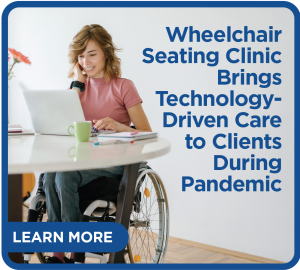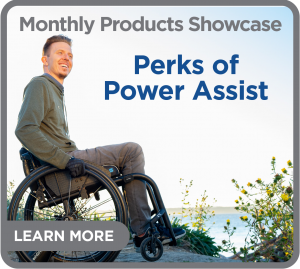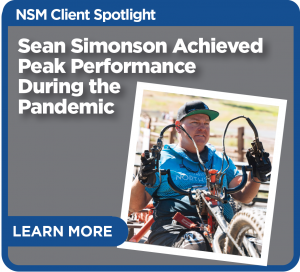Welcome to the NSM Monthly Minute
In this issue:
- CMS Temporarily Extends Rate Protections for Manual CRT Accessories
- Wheelchair Clinic Brings Technology-Driven Care During the Pandemic
- Monthly Products Showcase: Perks of Power Assist
- NSM Client Spotlight: Sean Simonson Achieved Peak Performance During the Pandemic
 CMS Temporarily Extends Rate Protections for Manual CRT Accessories
CMS Temporarily Extends Rate Protections for Manual CRT Accessories
It’s been a busy and productive week regarding stopping the July 1 Medicare cuts to CRT manual wheelchair accessories.
Here's a recap of what has happened this last week and the next steps to make this permanent.
- While we did not get the permanent fix yet, given the dynamics at CMS over the past 12 months (pandemic, elections, new administration, not having a CMS Administrator in place until three weeks ago) this really was the BEST outcome we could expect at June 30. This gives time for the now fully staffed CMS to make decisions like this and based on meetings that Rep. Larson and NCART had with CMS on Wednesday it “seems” like CMS may be heading down the right path, but we can not assume.
- This was a great industry/consumer/clinician push to be sure these cuts did not go into effect. Our thanks to all the NCART Board members and their organizations for their help. We especially thank the consumer and clinician groups that wrote letters and held calls with Congress: United Spinal, ITEM Coalition, Christopher and Dana Reeve Foundation, ALS Association, Spina Bifida Association, Center for Medicare Advocacy, and Clinician Task Force, and thanks to our industry partners NRRTS and AAHomecare. Finally, special thanks to those who were in DC this week having meetings: Chris Yule, Seth Johnson, Tom Powers, Amy Cunniffe, and Pattie DeLoatche. Coordinated and collective advocacy does work!
- Larson has been a true champion. He weighed in with Secretary Becerra on multiple occasions, led the sign-on letter to Administrator Brooks-LaSure, and set up a personal meeting with CMS leadership. At the CMS meeting he stressed the need to make this permanent, just like they did for power accessories. CMS told him they agree with many of his points and “are exploring options to make this permanent”. That is not a “yes”, but he felt the meeting was positive and they are heading in the right direction. He also told them he would do whatever he can to help with the regulatory process. The best indication of his ongoing commitment was a tweet he sent out yesterday that read “This access was set to expire on June 30th, but I led a letter to @CMSGov urging them extend it. GOOD NEWS: CMS announced that they've extended access before it was set to expire on June 30th. I will continue to fight to make this access permanent!” He recognizes there is more work to be done.
- We had a good meeting with the CMS Team Wednesday afternoon and we thanked Jason Bennett for the CMS action. He shared the challenges that CMS has been under these past 18 months (see above), yet they were able to offer a delay based on the reasons in their announcement. We asked what else we can do to move the process forward and he indicated they have received “thorough” public comments on this issue from the DMEPOS proposed rule and that he has the other information that NCART has shared outside of that. He has all he need and when asked about timing, he indicated they expect to have more internal bandwidth as they go through July and August on matters like this. He said if we do not hear from him by early to mid-August we should follow up, and we will.
- Next Steps and How You Can Help: We need everyone to keep this alive by reaching back out to the Congressional offices who were contacted and do two things: (a) let them know the good news and thank them for their support, and (b) tell them we will keep them updated as we work to ensure CMS makes this permanent this quarter. Click here for the steps to contact your local representative. We will be following up with the CMS team the first week of August for an update if we have not heard anything before then.
The 90-day delay was the most we could reasonably expect given all the negative dynamics and it was great we were able to get it. Now the stage is set for a final push to make permanent. We will keep the pressure on and be ready to react if CMS does not take the needed action.
 Wheelchair Seating Clinic at the Shepherd Center in Atlanta Brings Technology-Driven Care to Clients During Pandemic
Wheelchair Seating Clinic at the Shepherd Center in Atlanta Brings Technology-Driven Care to Clients During Pandemic
When Savannah Moore was evaluated for a new power wheelchair at the end of 2019, she’d imagined getting fitted for it in person. Months later, the world was in the midst of the COVID-19 pandemic, and in-clinic gatherings were a thing of the recent past. So in April of last year, Moore set up a hybrid virtual appointment.
She donned a mask, welcomed an assistive technology professional (ATP) into her home, and launched a video call on the ATP’s tablet. A physical therapist from her clinic appeared on the screen, ready to help from afar.
“I had to turn at different angles for [my therapist] to see me,” says Moore, who sat in full view of the camera and fielded questions while her therapist and ATP worked together to gauge her positioning. Was she sitting up straight? Were her feet in a good place?
Moore’s answers helped them make the proper adjustments to her wheelchair. From there: a spin around the neighborhood.
It was her first telehealth appointment.
Virtual Care
It sounds fancy, but telehealth just refers to health-related services conducted remotely via technology. The concept isn’t new, but it gained traction during the pandemic because in-person visits raised the risk of contracting COVID-19.
Telehealth covers a wide range of care, from wellness visits to remote health monitoring via wearable devices and urgent care for conditions that aren’t life-threatening. It’s just one aspect of technology-driven care.
Another aspect includes remote service evaluations. While telehealth visits are considered clinical encounters where therapists and ATPs work together to fit and evaluate a client, remote service evaluations allow technicians to troubleshoot problems or identify the issue so parts can be ordered to repair the problem.
Chances are, you’ve encountered tech-driven care at some point. Maybe you had a telehealth appointment with a physical therapist or used remote services to troubleshoot equipment issues. You may have even been evaluated for a new wheelchair via video call.
Big Benefits
Virtual care is sometimes met with skepticism. Is service really as good when it takes place over video? In many situations, the answer is yes.
That’s especially true for remote repair evaluations, which use a video diagnostic tool to inspect your equipment, determine why it’s not working, and set the repair process in motion. About 65 percent of problems are diagnosed right on the call, says Lee Andersen, senior manager of remote service support at National Seating & Mobility (NSM).
Remote services aren’t just convenient. “In most cases, we see a shorter turnaround time that can be up to two weeks,” Andersen says. Simply put, they get you back to being mobile faster than in-person service.
You’ll still get a personal touch. Techs often work with your ATP to make sure you’re cared for. Take Nicole Gahman, a Philadelphia-based remote repair tech with NSM. When she notices a wheelchair is in disrepair, she’ll contact the client’s ATP to start the process of getting a new one.
The ordering process can take place remotely too. Lisa Cordero, a New York–based ATP, recently started using video technology to evaluate the functionality and mobility of her patients. She expected a steep learning curve, but she never anticipated the benefits.
“We’re able to get a better visual of their home environment,” she says. “If they say, ‘I can’t get into the bathroom,’ I can say, ‘Walk me through it.’”
Admittedly, some things are harder to accomplish virtually. Cordero often asks caregivers to measure patients for new equipment, but she usually needs to confirm the measurements in person. Recently, Cordero and Dawn Baratta, a physical therapist in New York, completed a wheelchair clinic during which they spoke virtually with the client, her mother and her therapist. A few weeks later, they followed up in person and recorded the measurements Cordero needed to complete an order for a new wheelchair. While in-person physical therapy is best, Baratta notes, virtual evaluations can be helpful.
But in person isn’t always an option. Technology offers accessibility. People in rural areas who travel long distances for care have the option of remote appointments. Telehealth evaluations include therapists, so transparency isn’t limited. The evaluations can be recorded and archived, giving you and your care team a record of the appointment. In the middle of a pandemic, remote appointments allow for social distancing, while still guaranteeing quality care.
Even Cordero’s clients in New York City benefit. When public transit or ambulette service fails—or the elevator in a client’s high-rise apartment breaks—there’s a telehealth alternative.
The Future Is Now
The pandemic may have launched technology-driven care into the mainstream, but one thing is clear: it’s here to stay. It makes service more accessible, helps you get care faster, and gets you back to living your life, pronto.
“Clients really depend on these devices or the equipment they’re in,” says Andersen. “Our job is to get them back and being mobile again.”
Remote Appointment Prep
Getting ready for your first telehealth visit or remote evaluation? Keep these tips in mind.
- Have the necessary technology. This usually includes a smartphone and Wi-Fi access. Be sure to test the tech before the appointment and get comfortable with the platform you will use during your appointment.
- Keep your insurance information nearby. You’ll probably have to verify this at the start of the call.
- Don’t go it alone. Have a family member or caregiver present to assist as needed during the appointment.
- Make a list. Kenneth Anthony, a Philadelphia resident who has used a wheelchair for three decades, suggests listing all of the issues you’d like to discuss. This ensures you don’t forget anything.
- Wear tight-fitting clothing and avoid layers. This will help your physical therapist and ATP get a better sense of your positioning and movement.
- Look at yourself in a mirror. Savannah Moore used this trick when getting her wheelchair adjusted. She spotted uneven foot plates that she hadn’t noticed before.
- Choose the right location. Set up in an area with good lighting. When using telehealth for physical therapy, clear a space on the floor or have a bed nearby. You may need the open area for certain moves. When picking out new equipment, sit on a firm surface. Cushy chairs and couches make it harder for your ATP to get a sense of your positioning and balance.
- Take your equipment for a spin. At her last appointment, Moore rode her new wheelchair around the neighborhood to make sure it was adjusted to her preference.
 Monthly Products Showcase: Perks of Power Assist
Monthly Products Showcase: Perks of Power Assist
Life should be lived to the fullest, and a power assist device can help make that more achievable for many manual wheelchair users. Whether you’re sightseeing on vacation or running your day-to-day errands, power assist can give you a little bit of an extra push when you need it most. While power assist isn’t new, thanks to advancements in technology and design, more options are currently available than ever before.
Overview
In the simplest terms, power assist provides manual wheelchair users with power when they need it. Power assist:
- Requires less force to propel, reducing the number of pushes needed to go the same distance;
- Makes it easier to propel over difficult terrain such as grass, gravel, carpet, curb cuts, ramps and inclines;
- Allows users to do more while using less energy, which helps fight fatigue and overuse injuries, such as carpal tunnel and rotator cuff problems. “Power assist helps give people the ability to do more,” said Mike Salvi, director of mobility and seating at Invacare. “But it also helps prevent pain, fatigue and injury. Power assist can help reduce the risk of upper extremity injury due to decreased burden and helps users maintain more neutral joint positions.”
Benefits to users include:
- Greater connectivity: Bluetooth gives you the ability to control speed and customizable settings with an app. It’s now possible to control some products without being in the chair, making it easy to store when not being used.
- Safety: Many products offer increased speed to cross busy streets or assisted braking when going downhill, helping to make daily life a little more safe.
- Improved drivability and transportability: Thanks to continued innovations, products continue to get lighter and easier to remove for travel, while engines are becoming stronger and more efficient, helping you get where you’re going with a little less hassle.
Types
Manual wheelchair users have two main options when it comes to power assist: power assist wheels or an add-on unit. In deciding between the two, experts suggest taking stock of your goals and finding the right combination of options that fit your lifestyle.
You and your care team should consider functional and comfort levels as well as safety when making decisions about which product might work best. If you qualify, power assist may be covered by insurance, whether you’re a new or existing user. Private pay options are also available. If you have questions, consult your doctor, therapist or National Seating & Mobility.
 NSM Client Spotlight: Sean Simonson
NSM Client Spotlight: Sean Simonson
Sean Simonson’s list of accomplishments is impressive. Firefighter, world champion mountain bike racer and Harvard graduate are a few of his many achievements.
While the global pandemic may have pushed pause on Simonson’s racing, it hasn’t slowed him down at all. For Simonson, the future is still looking up.
Dropping In
Growing up in Southern California, Simonson was an avid mountain bike racer and surfer. At 14, all he dreamed of was becoming a firefighter. In 1997, after graduating from the University of California, Santa Barbara, that dream became a reality when Simonson was hired as a firefighter for the city of Milpitas.
“After 10 years as a fireman, my brother and I decided to do a bike ride from the Canadian to the Mexican border,” Simonson said. “We started training in Santa Cruz. One day, I was riding after a really heavy rain. I came out onto a fire road and the potholes had been filled with sediment that was still soft, so it was hard to tell they were there. I hit a deep pothole, and it absorbed my entire front wheel. I flew over the handlebars forehead first, and my body followed.”
Simonson was airlifted to Stanford Medical and underwent emergency surgery. He was diagnosed as a C6, C7 quadriplegic.
Only 35 days following Simonson’s release from the hospital, he competed in his first athletic event as a quadriplegic—the Silver Strand Half Marathon in San Diego. During the competition, Simonson was introduced to the Challenged Athletes Foundation (CAF), a nonprofit that provides opportunities and support to people with physical challenges so they can pursue active lifestyles.
"Sean is an amazingly talented athlete who hasn’t let his disability slow him down. Not only has he been a great athlete in sports like triathlon and off-road handcycling, but he also gives back to the adaptive community through mentorship and coaching," said Travis Ricks, CAF Director of Programs.
CAF happened to have a racing wheelchair available for Simonson to use during the Silver Strand Half Marathon.
“I tried it and got coaching from two of the top athletes in the world for wheelchair racing, which was a total honor,” Simonson recalled. “They told me I could take it home. I promised them I’d ride the wheels off of it.”
Diving In to Downhill
It was a promise Simonson quickly made good on.
Not long after the marathon, Simonson learned about a new style of mountain bike racing called enduro. Developed in Europe, enduro combines elements from multiple disciplines of racing. Bikers compete in downhill timed stages that can vary in steepness, length and difficulty, depending on the location.
“I had to climb up a ski resort and race down three or four times,” Simonson said. “I wasn’t sure I’d be able to do it, but I finished it. It was the first documented time a quadriplegic or person in a wheelchair had ever entered and finished an enduro mountain bike race.”
Simonson continued competing in California, placing in the China Peak Enduro. Soon after, he was invited to compete in the Enduro World Series.
“I went straight to the world series,” Simonson said. “I trained my butt off for the 35 days leading up to the tournament. We placed first place in our class. I am the first quadriplegic to enter, race, finish and place in an Enduro World Series event anywhere in the world.”
Upshift
In 2019, Simonson was invited to the Enduro World Series circuit in Italy, a race intended to take place in the summer of 2020.
“I started training even harder to travel to Italy to race… and then COVID hit,” Simonson recalled. “I had this plan to go even farther, and I had legitimately earned my spot. To have it cancelled was difficult. Luckily, I live biking distance from some dirt, and that’s where I hunkered down. I’ve been working to keep my fitness and spirits up.”
As soon as he’s able, Simonson plans to resume competing with hopes to qualify for a spot on the world stage once again.
“I don’t know what the top is for me,” Simonson said. “I shouldn’t have gotten into Harvard, but I did. I shouldn’t be a world champion mountain bike racer, but I am. I shouldn’t be out of bed without 24-hour care, but I am. Where’s my top? I still haven’t found my peak.”
Getting Started
Interested in handcycling? Here are Sean’s top three tips to get started.
- Always wear a helmet and never ride alone.
- Set cycling goals that are out of your comfort zone and continue to safely push that zone farther and farther.
- Be a great ambassador on the trail for people with disabilities and mountain biking.




